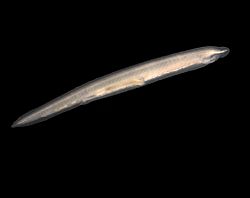Lancelet facts for kids
Quick facts for kids Lancelets |
|
|---|---|
 |
|
| A lancelet (Branchiostoma lanceolatum) | |
| Scientific classification | |
| Kingdom: | |
| Phylum: | |
| Subphylum: |
Cephalochordata
Owen, 1846
|
Lancelets, also known as Cephalochordata, are a small group of sea animals. They are special because they are very simple chordates. Chordates are animals that have a flexible rod supporting their back at some point in their lives. Long ago, lancelets were called Amphioxus. One very old relative of the lancelet is Pikaia.
Lancelets are like living fossils! They are the modern-day survivors of a very old group of chordates. Scientists have found their fossils from the Cambrian period, which was over 520 million years ago. Many scientists believe lancelets are the closest relatives to animals with backbones, called craniates. There are about 30 different species of lancelets, divided into two main groups, or genera.
You can usually find lancelets buried in the sand. They live in shallow parts of the temperate or tropical seas. In some parts of Asia, people catch lancelets. They are used as food for both humans and farm animals. Scientists also study lancelets a lot in zoology, which is the study of animals. This is because lancelets can help us understand how vertebrates, animals with backbones, first appeared and changed over time.
What Makes Lancelets Special?
Lancelets are very important for understanding how vertebrates have evolved and adapted. Even though lancelets separated from vertebrates more than 520 million years ago, their genomes (which are like their complete set of instructions for life) give us clues about evolution. They show how vertebrates might have used old genes for new purposes. Scientists think lancelets look a lot like the basic form of an early vertebrate.
Scientists have even studied the genome of a specific type of lancelet, the Florida lancelet (Branchiostoma floridae). Many experts agree that lancelets are the closest relatives to vertebrates. This is based on many physical features they share that are not seen in tunicates, another group of simple chordates.
Images for kids



